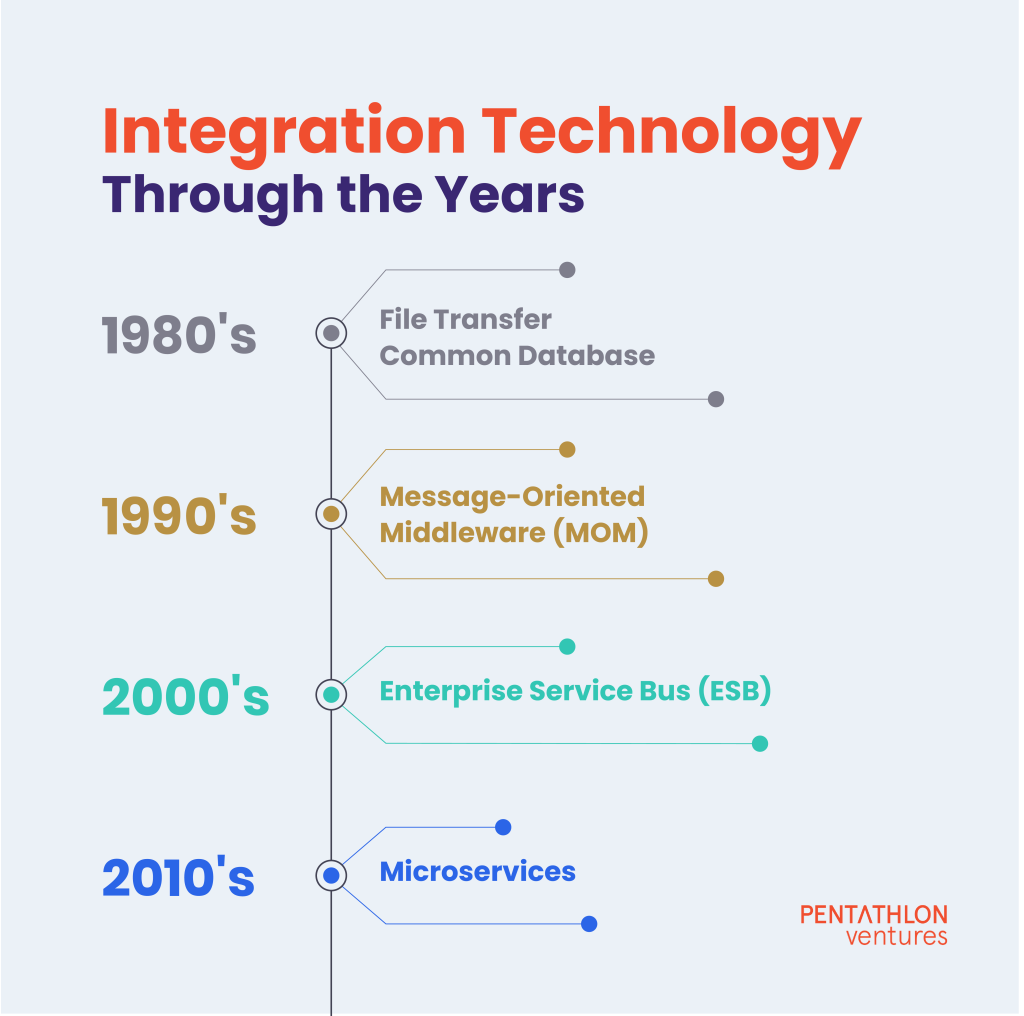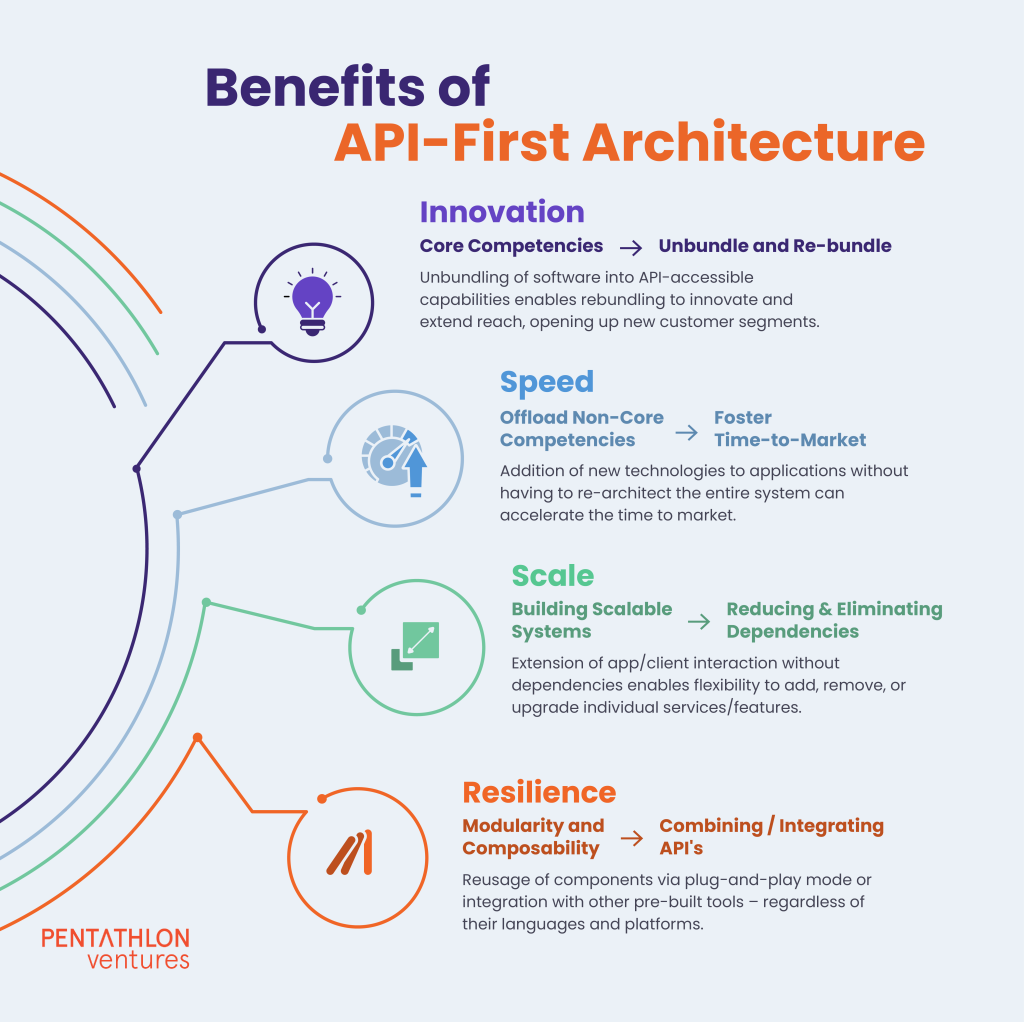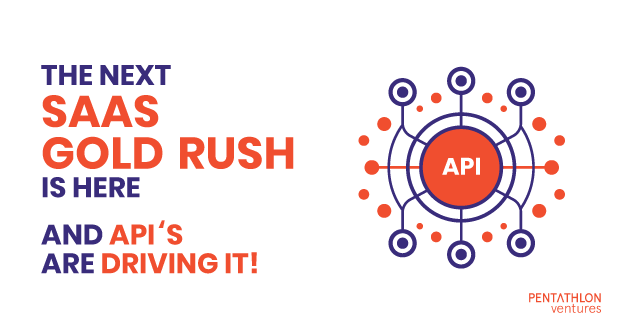How far back in time would you travel if you had a time machine? For a regular person, traveling back even a decade would be a huge shock. Large parts of our current reality either didn’t exist or were in their infancy. In a little over ten years, social media, IoT, voice searches, short-form video sharing, workplace collaboration etc., have boomed, and software has entered every facet of our lives.
Things are no different for businesses. Over the last decade, the number and variety of enterprise software and adoption rates have exploded. As companies grow, the number of applications they use grows with them. Executive teams need multiple software solutions to improve their management. Sharing data and feature sets enabled by linking of these applications becomes more critical. This need for integration spans from internal processes to those running outside the organization and poses challenges to managing access and security. This further brings in the complexity of control, security and access.
Integration technology through the years
Integration dates back to the 1980s, when common database and file sharing were some of the oldest mechanisms of information access across different systems. But they had limitations when it came to scalability and operating in real-time.
Then around the 1990s, the introduction of Object Request Broker and Message oriented middleware (MOM) enabled real-time data and functionality exchange.
Then early 2000’s saw the Enterprise Service Bus (ESB) implementations, which made integration focus on business semantics, followed by an emerging wave of web services and service-oriented architecture. This allowed systems to have machine-readable contracts and interface definitions.

When large technology firms started providing public APIs, developers and other businesses entered a new era of flexibility. Although these public APIs have historically remained on the sidelines, we’re witnessing the emergence of new business models with APIs at their very center.
Tailwinds and Headwinds
According to a recent survey by O’Reilly conducted among 1,500 software engineers, 61% said their organizations have been using microservices for a year or more and 28% for at least three years. While microservices architecture has been adopted by an increasing number of enterprises in recent years, real-time data access across applications is becoming critical, right from internal reporting and visualization to fraud detection.
Further, the scope of integrations has enabled organizations to collaborate and share distribution or territorial implementations. Emerging tools are helping API developers build performant, highly available and secure applications, ensuring high quality, security, data synchronization, and end-to-end adoption.
On the other hand, as APIs are more widely used and distributed, the attack surface areas tend to grow. This means developers have to do more to combat complex DDoS attacks, authorisation errors, and unintentional data exposure. Re-engineering efforts in terms of modernizing existing components, running as a single codebase, could require excessive refactoring and addition of new layers, pushing enterprises towards a hybrid approach.
Legacy / mainframe applications can also be made available via API wrappers.
API-first Businesses
APIs are no longer a stopgap for fast-moving developers — they’re a fundamental element of their strategy. Why would you spend valuable resources reinventing the wheel instead of focusing on building something unique? It allows companies to focus on adding business value rather than reinventing components.
API-rich products, therefore, have the potential to become part of multiple go-to-market strategies and product roadmaps. The market is full of success stories from the API-first approach.
Twilio: Twilio is the epitome of API-driven technology. They are a platform-as-a-service for cloud communications. Developers may utilize their APIs to send and receive text messages and phone calls programmatically.. Founded in 2008, Twilio has a market cap of $17billion and reported revenue of $2.84 billion, up 61% Year-Over-Year.
Segment: They’ve built APIs to enable developers/businesses to unify customer data from every customer touchpoint. It empowers marketing, sales, and customer service leaders with the insights they need to design and build relevant, data-driven customer engagement. Founded in 2013 it was acquired by Twilio for $3.2B in 2020.
SendGrid: SendGrid’s Web API helps companies send marketing emails. Founded in 2009, SendGrid raised $131 million after pricing its IPO and went public in 2017. Its revenue for 2016 was $79.9 million and was acquired by Twilio for $3B in 2019.
Stripe: Stripe’s success is primarily due to the challenge they uncovered and solved. When it came to payment processing before Stripe, developers were in a bind. They had no choice except to utilize a self-hosted gateway or a branded 3rd party alternative such as Paypal. Founded in 2010, analysts estimate Stripe handles $50 billion in commerce annually, which would translate to about $1.5 billion in revenue.
Plaid: Their API helps companies build fintech solutions by making it easy, safe and reliable for people to connect their financial data to apps and services. Founded in 2013, it recently raised $425M, boosting Plaid’s valuation to $13.4 billion.
Postman: Their API is a collaborative platform for developers to build, design, test, and iterate their APIs. Today, it is used by more than 17 million developers and over 500,000 organizations. Founded in 2014, it raised $225 million in a new financing round that values it at $5.6 billion, up from $2 billion a year ago.
API-First evolving ecosystem → “Horizontal” OR “Vertical” First?
“Horizontal First” and “Vertical First” tools increasingly play a crucial role in integrating and facilitating specific feature sets. Horizontal First platforms could be defined as the ones which enable any company, regardless of the vertical, to integrate broader functionality such as payments, communication and security. Vertical First platforms cater to industry-specific challenges such as transmitting patient data for healthcare use cases or utilizing customer transaction history in banking and financial services. Widening integration scope helps companies expand to API-based use cases if they weren’t API-first since inception. This, in turn, enables them to develop customer usage strategically.
Third-party API companies are changing the dynamics of how products are built and brought to market. As more SaaS founders build in the space, sector and function-specific categories have started forming.
Riskcovry: Riskcovry’s “API in a box” approach changes insurance distribution from “push” using agents to “pull” by bundling insurance with the products of their non-insurance partners, such as travel, retail, etc.
Rightfoot: Rightfoot’s APIs enable developers across financial wellness, payroll and employer benefits companies to quickly and easily add debt payments to any application — automating repayments from a borrowers’ paycheck across outstanding debts or creating tax-free student debt repayment programs.
Finch: Finch’s API solution enables sharing of employee information including timeline, salary, title including health, dental, etc and enables employees with loans & mortgage solutions, direct deposit payments, and rent applications.
Commerce Layer: Commerce Layer, a headless solution, is a transactional commerce API that lets you add multi-market ecommerce to any digital experience including point of sale and subscription elements.

“API Banking is playing a key role in money transactions today, and we will see a lot of the volume coming from the BFSI segment. But innovations around APIs will happen from all nooks and corners of different industries. It won’t be restricted to BFSI”
Shashank Mehta | Razorpay (Source: The Times of India)
Benefits of API first architecture
Innovation: Well-designed APIs support pluggable, component-based architecture that offer the flexibility to add, remove, or upgrade individual services/features while reducing the chance of impacting other parts of the system. Scope of re-bundling the capabilities enables to expand GTM channels and extend reach to new customer segments.
Speed: Faster time to market is a substantial competitive advantage for most companies, so saving development time means enormous financial benefits. Companies can speed up the overall product development as not every feature-set must be coded from scratch. The parallel development process eliminates dependencies.

“Indian enterprises are at the low to mid level of maturity in their API journey. There is greater adoption amongst large enterprises. The pandemic has accelerated the process of building API capabilities. It could be a revenue stream or help reduce costs”
Akash Jain | Principal Analyst. Gartner (Source: The Times of India)
Scale: Because APIs are loosely connected, their services are as stateless as feasible. REST APIs provide “loose” connections while reducing or removing dependencies, improving scalability by deploying, replicating, and deleting systems in response to changing demands. Risk of failure is also reduced due to inherent reliability, and consistency of design and implementation.
Resilience: API-first makes adding new functionalities easier. It also makes it easy for external applications to embed your services. Development teams can re-use different app components in other projects and integrate with the APIs of other pre-built microservices components. APIs offer a language and platform agnostic interface with which different microservices can interact.
“We opened up our core capability of executing trades because technologists were not coming forward to build securities tech. There were legal, compliance deterrents. Today, they can use our APIs to build on top of our platform, without a broking license of their own”
Kailash Nadh | CTO, Zerodha (Source: The Times of India)
Open-source APIs
The value of open source APIs is that it encourages innovation through collaboration, removing barriers across innovators to enable wholesome technological advancement and gives universal access to software programs for companies. The open source API ecosystem has evolved significantly wherein there are tools available across the spectrum of the API management – API Umbrella, WSO2, Gravitee, Tyk, Fusio, APIMan. While some of these offer community specific versions in the form of open source, they also offer commercial versions
Some of the prominent open-source APIs include:
- Fusio is an open-source option for constructing and managing APIs and comes with lifecycle management features such as back-end dashboards for admin control.
- Keycloak helps to add authentication to applications and secure services and includes advanced features like user federation, identity brokering, and social login.
- Spacy.io is available as API and SaaS. It integrates natural language processing into applications.
- API Umbrella: An open source api management which enables multiple organizations to operate under the same umbrella by empowering varying admin permissions for different domains.The platform also provides facilities like Rate limiting, API keys and caching
- Repose: An open-source RESTful middleware platform which is built with an aim to provide downstream services for trusting incoming requests when well-formed and validated.IT offers various API processing facilities, authentication, API validation and rate limiting.
Sharing an API-led vision
APIs have unlocked huge potential for this decade’s SaaS Gold rush, and it will become a stronger enabler as the whole landscape evolves. It not only provides building blocks to assemble relatively easy functions into complex applications quickly, but the APIs that products consume could expose their own API. This further helps developers bring modular alternatives of their product to market and eliminate any dependency on lock-in to any particular platform. Outcomes span beyond the internal organization as easy access brings in a multi-fold impact on external stakeholders, customers, vendors and other partners. Evolving API ecosystem will continue to allow businesses to build more productive workflows, bring products and features to market faster, and create modern user experiences that drive adoption and retention. It doesn’t require large amounts of time and resources, allowing teams to focus on other critical issues and business goals. APIs have the potential to improve efficiency and profitability by optimizing resources and opening new revenue opportunities through the broader microservices outlook.
As SaaS explodes with more and more digital transformation, the developers and product leaders will look out for the critical connective tissue that will encourage further API innovation. This provides a massive opportunity for founders to build one. One of the core advantages while building an API first product is the ability to adapt and experiment with multiple adoption routes quickly – you can choose to expose only one function as an API to complete the product as an API. An efficient distribution strategy could set in significant network effects to unfold large volumes, resulting in both a faster scale and a capital efficient one. More importantly, the approach would require the building team to share an API-led vision.
